Intel's Ivy Bridge Architecture Exposed
by Anand Lal Shimpi on September 17, 2011 2:00 AM EST- Posted in
- CPUs
- Intel
- Ivy Bridge
- IDF 2011
- Trade Shows
The New GPU
Westmere marked a change in the way Intel approached integrated graphics. The GPU was moved onto the CPU package and used an n-1 manufacturing process (45nm when the CPU was 32nm). Performance improved but it still wasn't exactly what we'd call acceptable.
Sandy Bridge brought a completely redesigned GPU core onto the processor die itself. As a co-resident of the CPU, the GPU was treated as somewhat of an equal - both processors were built on the same 32nm process.
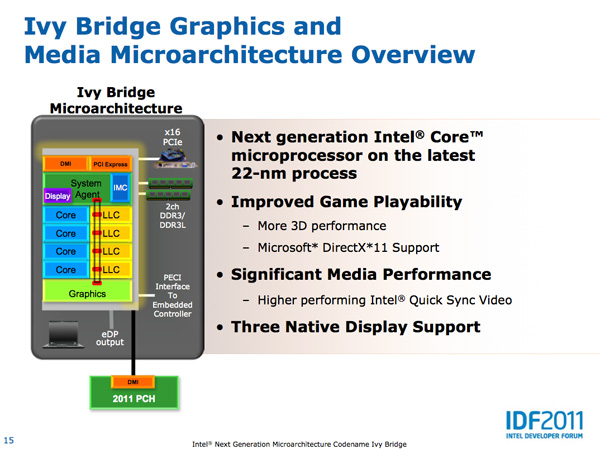
With Ivy Bridge the GPU remains on die but it grows more than the CPU does this generation. Intel isn't disclosing the die split but there are more execution units this round (16 up from 12 in SNB) so it would appear as if the GPU occupies a greater percentage of the die than it did last generation. It's not near a 50/50 split yet, but it's continued indication that Intel is taking GPU performance seriously.
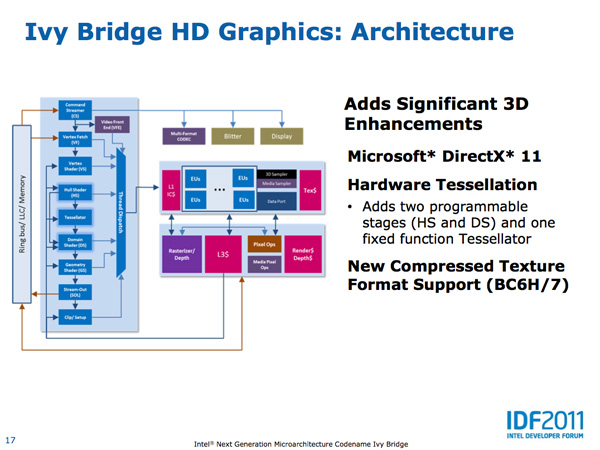
The Ivy Bridge GPU adds support for OpenCL 1.1, DirectX 11 and OpenGL 3.1. This will finally bring Intel's GPU feature set on par with AMD's. Ivy also adds three display outputs (up from two in Sandy Bridge). Finally, Ivy Bridge improves anisotropic filtering quality. As Intel Fellow Tom Piazza put it, "we now draw circles instead of flower petals" referring to image output from the famous AF tester.
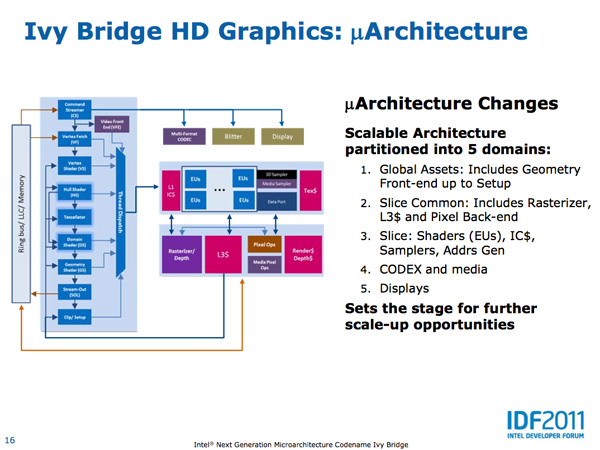
Intel made the Ivy Bridge GPU more modular than before. In SNB there were two GPU configurations: GT1 and GT2. Sandy Bridge's GT1 had 6 EUs (shaders/cores/execution units) while GT2 had 12 EUs, both configurations had one texture sampler. Ivy Bridge was designed to scale up and down more easily. GT2 has 16 EUs and 2 texture samplers, while GT1 has an unknown number of EUs (I'd assume 8) and 1 texture sampler.
I mentioned that Ivy Bridge was designed to scale up, unfortunately that upwards scaling won't be happening in IVB - GT2 will be the fastest configuration available. The implication is that Intel had plans for IVB with a beefier GPU but it didn't make the cut. Perhaps we will see that change in Haswell.
As we've already mentioned, Intel is increasing the number of EUs in Ivy Bridge however these EUs are much better performers than their predecessors. Sandy Bridge's EUs could co-issue MADs and transcendental operations, Ivy Bridge can do twice as many MADs per clock. As a result, a single Ivy Bridge EU gets close to twice the IPC of a Sandy Bridge EU - in other words, you're looking at nearly 2x the GFLOPS in shader bound operations as Sandy Bridge per EU. Combine that with more EUs in Ivy Bridge and this is where the bulk of the up-to-60% increase in GPU performance comes from.
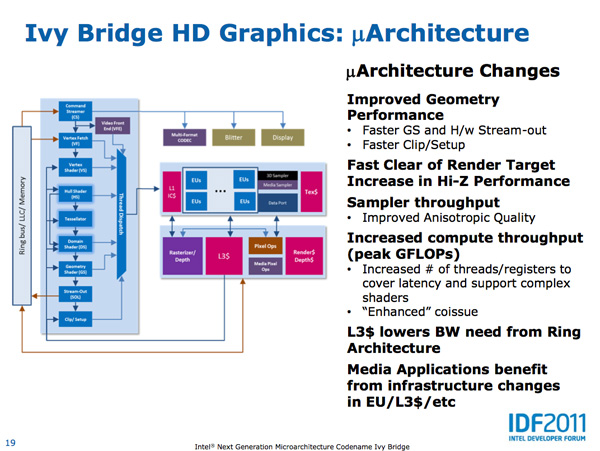
Intel also added a graphics-specific L3 cache within Ivy Bridge. Despite being able to share the CPU's L3 cache, a smaller cache located within the graphics core allows frequently accessed data to be accessed without firing up the ring bus.
There are other performance enhancements within the shader core. Scatter & gather operations now execute 32x faster than Sandy Bridge, which has implications for both GPU compute and general 3D gaming performance.
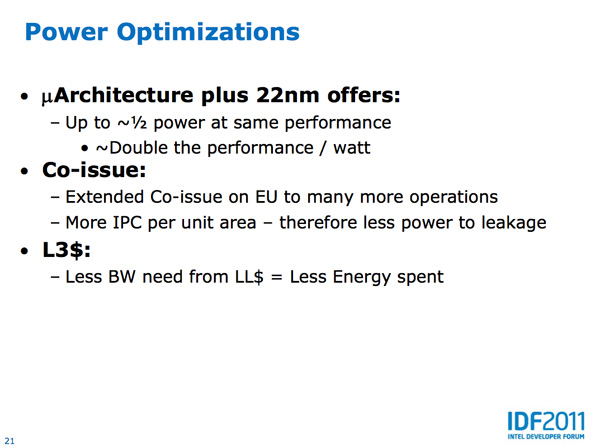
Despite the focus on performance, Intel actually reduced the GPU clock in Ivy Bridge. It now runs at up to 95% of the SNB GPU clock, at a lower voltage, while offering much higher performance. Thanks primarily to Intel's 22nm process (the aforementioned architectural improvements help as well), GPU performance per watt nearly doubles over Sandy Bridge. In our Llano review we found that AMD delivered much longer battery life in games (nearly 2x SNB) - Ivy Bridge should be able to help address this.
Quick Sync Performance Improved
With Sandy Bridge Intel introduced an extremely high performing hardware video transcode engine called Quick Sync. The solution ended up delivering the best combination of image quality and performance of any available hardware accelerated transcoding options from AMD, Intel and NVIDIA. Quick Sync leverages a combination of fixed function hardware, IVB's video decode engine and the EU array.
The increase in EUs and improvements to their throughput both contribute to increases in Quick Sync transcoding performance. Presumably Intel has also done some work on the decode side as well, which is actually one of the reasons Sandy Bridge was so fast at transcoding video. The combination of all of this results in up to 2x the video transcoding performance of Sandy Bridge. There's also the option of seeing less of a performance increase but delivering better image quality.
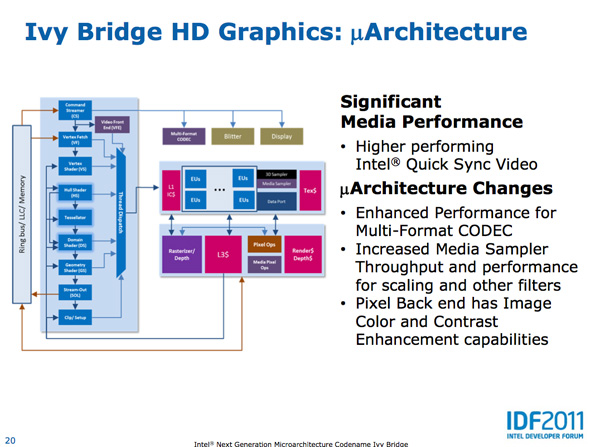
I've complained in the past about the lack of free transcoding applications (e.g. Handbrake, x264) that support Quick Sync. I suspect things will be better upon Ivy Bridge's arrival.
















97 Comments
View All Comments
Meegulthwarp - Saturday, September 17, 2011 - link
Thanks man, you're a star. You really should just ignore whiny comments like mine as you provide some of the best (if not the best) tech articles online and its free of charge! Everytime you push a article like this my life comes to a standstill so I can read it. Keep up the good work!zshift - Saturday, September 17, 2011 - link
I agree with this 100%. I love reading the articles here on AnandTech. The articles are well written, and provide plenty of charts/data/photos to provide as much of a complete understanding as possible of the product in question.I also like the fairly recent upsurge in articles, you have a great team here.
PS: Bench rocks!
lowenz - Saturday, September 17, 2011 - link
From power page: "Voltage changes have a cubic affect on power"Cubic?
P ~ C * v^2 * freq * switching activity
know of fence - Saturday, September 17, 2011 - link
Cubic as in "to the third power".I remember a slide from on of the Intel presentations saying that, but i'd like to know how it comes about.
Vcore^3 ~ power
Here somebody posted some data of Vcore vs Power. If you were to plot power consumption in relation to Vcore^3 then one ought to get a linear graph.
http://www.awardfabrik.de/forum/showthread.php?t=6...
KalTorak - Saturday, September 17, 2011 - link
Cubic. Because f, for a big chunk of the V-f curve, tends to be linear in V.gevorg - Saturday, September 17, 2011 - link
Will IVB have 8-core unlocked CPUs like 2500K/2600K SNB?Sabresiberian - Saturday, September 17, 2011 - link
"Ivy Bridge won't get rid of the need for a discrete GPU but, like Sandy Bridge, it is a step in the right direction."I'm not so sure I'd agree getting rid of the need for a discrete GPU is a good thing. In terms of furthering technological possibilities, yes, I get that; in terms of me building the computer I want to build and tailoring the results to my purposes, I really don't want these things to be tied together in an inflexible way.
;)
platedslicer - Sunday, September 18, 2011 - link
Standardization seems to be the current trend... next thing you know, the computer industry has gone the way of car manufacturers.JonnyDough - Monday, September 19, 2011 - link
Standards are not all bad. In the case of car manufacturers, we now have things like sealed bearings (so you don't have to regularly grease the bearings in your wheels, and they actually last longer and cost less), safety systems like ABS, seat belts, airbags, etc.With computers, we need standards as well for compatibility. It lowers cost, ensures that hardware works fluidly between platforms, etc. If we didn't have standards we would have things like rambus - which would only cost us a fortune and slow technological progression.
JonnyDough - Monday, September 19, 2011 - link
I think the author means that you won't NEED a discrete CHIP (GPU other than the one on-die) to run a system. Discrete here seems to imply an IGP (integrated onto the motherboard) OR on a separate graphics card. That isn't to say one won't still be required for graphics intensive applications. Ideally, the on-die GPU will be able to work in tandem when a graphics card is installed.